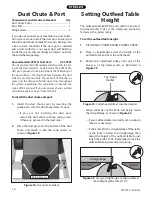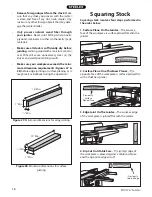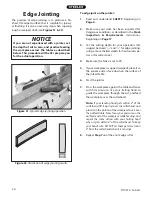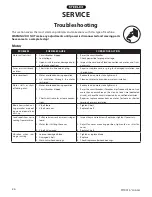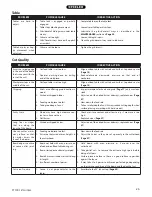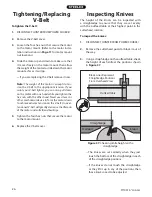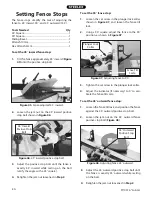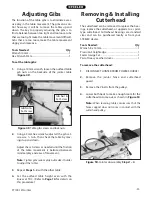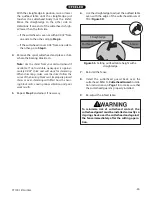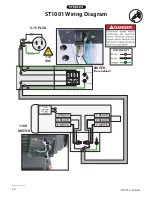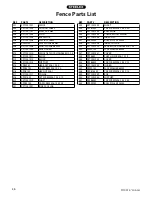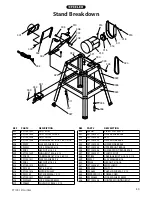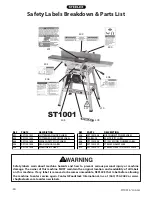
ST1001 6" Jointer
-25-
PROBLEM
POSSIBLE CAUSE
CORRECTIVE ACTION
Tables are hard to
adjust.
1. Table lock is engaged or partially
engaged.
2. Table stops blocking movement.
3. Gibs/dovetail sliding ways under table
are dry.
4. Gibs are set too tight.
5. Gibs/Dovetail ways have built up pitch
or sawdust.
1. Completely loosen the table lock.
2. Loosen/reset table positive stops.
3. Lubricate the gibs/dovetail ways as described in the
MAINTENANCE
section on
Page 23
.
4. Loosen table gib screws.
5. Clean the gibs/dovetail ways and re-lubricate.
Table has play or slop-
py movement when
adjusted.
1. Gibs are set too loose.
1. Tighten the gib screws.
Table
PROBLEM
POSSIBLE CAUSE
CORRECTIVE ACTION
Excessive snipe (gouge
in the end of the board
that is uneven with the
rest of the cut).
1. Outfeed table is set too low.
2. Operator pushing down on trailing
end of the workpiece.
1. Align outfeed table with cutterhead knife at top dead center
(
Page 14
).
2. Reduce/eliminate downward pressure on that end of
workpiece.
Workpiece stops in the
middle of the cut.
1. Outfeed table is set too high.
1. Align outfeed table with cutterhead knife at top dead center
(
Page 14
).
Chipping.
1. Knots or conflicting grain direction in
wood.
2. Nicked or chipped blades.
3. Feeding workpiece too fast.
4. Taking too deep of a cut.
1. Inspect workpiece for knots and grain (
Page 17
); only use clean
stock.
2. Adjust one of the nicked knives sideways; replace knives (
Page
27
).
3. Slow down the feed rate.
4. Take a smaller depth of cut. (Always reduce cutting depth when
surface planing or working with hard woods.)
Fuzzy Grain.
1. Wood may have high moisture con-
tent or surface wetness.
2. Dull knives.
1. Check moisture content and allow to dry if moisture is too
high.
2. Replace knives (
Page 27
).
Long lines or ridges
that run along the
length of the board.
1. Nicked or chipped knives.
1. Adjust one of the nicked knives sideways; replace knives (
Page
27
).
Uneven cutter marks,
wavy surface, or chat-
ter marks across the
face of the board.
1. Feeding workpiece too fast.
2. Knives not adjusted at even heights in
the cutterhead.
1. Slow down the feed rate.
2. Adjust the knives so they are set up evenly in the cutterhead
(
Page 27
).
Board edge is concave
or convex after joint-
ing.
1. Board not held with even pressure on
infeed and outfeed table during cut.
2. Board started out extremely warped.
3. Board has excessive bow or twist along
its length.
4. Insufficient number of passes.
1. Hold board with even pressure as it moves over the
cutterhead.
2. Take partial cuts to remove the extreme high spots before
doing a full pass.
3. Surface plane one face so there is a good surface to position
against the fence.
4. It may take 3 to 5 passes to achieve a perfect edge, depending
on the starting condition of the board and the depth of cut.
Cuts aren't square.
1. Fence is not perpendicular to the
tables.
1. Recalibrate the 90° fence stop (
Page 30
).
Cut Quality
Summary of Contents for ST1001
Page 2: ......
Page 36: ...34 ST1001 6 Jointer ST1001 Wiring Diagram...
Page 37: ...ST1001 6 Jointer 35 Jointer Breakdown...
Page 39: ...ST1001 6 Jointer 37 Fence Breakdown...
Page 44: ......
Page 47: ......
Page 48: ......




